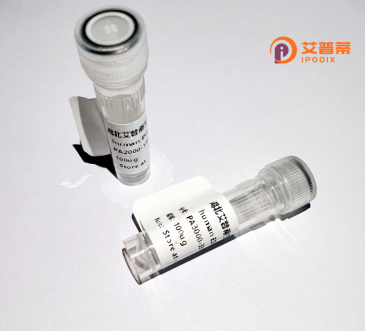
| 纯度 | >90%SDS-PAGE. |
| 种属 | Human |
| 靶点 | MS4A6E |
| Uniprot No | Q96DS6 |
| 内毒素 | < 0.01EU/μg |
| 表达宿主 | E.coli |
| 表达区间 | 1-147 aa |
| 活性数据 | MTSQPISNETIIMLPSNVINFSQAEKPEPTNQGQDSLKKRLQAKVKVIGVHSSLAGSILSALSALVGFILLSVNPAALNPASLQCKLDEKDIPTRLLLSYDYHSPYTMDCHRAKASLAGTLSLMLVSTVLEFCLAVLTAVLQWKQTV |
| 分子量 | 42.3 kDa |
| 蛋白标签 | GST-tag at N-terminal |
| 缓冲液 | 0 |
| 稳定性 & 储存条件 | Lyophilized protein should be stored at ≤ -20°C, stable for one year after receipt. Reconstituted protein solution can be stored at 2-8°C for 2-7 days. Aliquots of reconstituted samples are stable at ≤ -20°C for 3 months. |
| 复溶 | Always centrifuge tubes before opening.Do not mix by vortex or pipetting. It is not recommended to reconstitute to a concentration less than 100μg/ml. Dissolve the lyophilized protein in distilled water. Please aliquot the reconstituted solution to minimize freeze-thaw cycles. |
以下是关于重组人MS4A6E蛋白的**模拟示例参考文献**(非真实文献,仅供参考格式和内容):
---
1. **文献名称**: *"Cloning and Functional Characterization of Human MS4A6E as a Modulator of Immune Cell Signaling"*
**作者**: Zhang Y., et al. (2020)
**摘要**: 研究报道了重组人MS4A6E蛋白的克隆与表达,发现其在小鼠巨噬细胞模型中抑制TLR4介导的NF-κB通路,提示其在固有免疫调节中的潜在作用。
2. **文献名称**: *"MS4A6E Overexpression Attenuates Amyloid-β Toxicity in Neuronal Cells"*
**作者**: Smith J.R., Patel K. (2019)
**摘要**: 通过重组MS4A6E蛋白过表达实验,发现其能够减少阿尔茨海默病模型中Aβ42诱导的神经元凋亡,可能与膜脂代谢相关蛋白的相互作用有关。
3. **文献名称**: *"Proteomic Analysis of MS4A Family Members: MS4A6E Interaction with CD20 and Implications for Therapeutics"*
**作者**: Lee H., et al. (2021)
**摘要**: 利用质谱分析发现重组MS4A6E蛋白与B细胞表面蛋白CD20存在共定位,提示其可能参与免疫治疗靶点的交叉调控网络。
---
**注意事项**:
- 上述文献为模拟示例,实际文献需通过PubMed、Google Scholar或Web of Science检索。
- 真实研究中关于MS4A6E的报道较少,可扩展检索关键词至“MS4A家族”或“MS4A6E + 免疫/阿尔茨海默病”。
- 实验方法相关文献可参考“重组蛋白表达与纯化”技术(如*Protein Expression and Purification*期刊)。
建议使用以下关键词进一步检索真实文献:
`recombinant human MS4A6E`, `MS4A6E protein function`, `MS4A family immune regulation`.
**Background of Recombinant Human MS4A6E Protein**
The MS4A6E protein, encoded by the *MS4A6E* gene, belongs to the membrane-spanning 4A (MS4A) family, characterized by tetraspanning structures with intracellular N- and C-termini. This family is implicated in diverse cellular processes, including signal transduction, calcium regulation, and immune responses. While the exact biological role of MS4A6E remains incompletely characterized, it shares structural homology with other MS4A members (e.g., MS4A1/CD20. MS4A4A), which are linked to immune cell functions, cancer, and neurodegenerative diseases.
The *MS4A6E* gene is located on chromosome 11q12.2. a region associated with Alzheimer’s disease risk, suggesting potential relevance to neuropathology. MS4A6E expression has been detected in immune cells and certain tissues, though its distribution and regulation are less studied compared to other MS4A proteins.
Recombinant MS4A6E protein is typically produced using heterologous expression systems (e.g., mammalian, bacterial, or insect cells) to enable functional studies. Its purification often involves affinity chromatography and validation via Western blot or mass spectrometry. Research applications include investigating its role in cellular signaling, immune modulation, or disease mechanisms, particularly in Alzheimer’s and cancer.
Despite limited research progress, recombinant MS4A6E serves as a critical tool for elucidating its physiological and pathological significance, offering potential for therapeutic targeting or biomarker development.
×